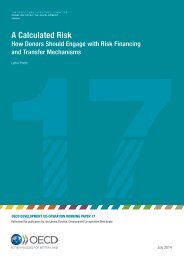UNIVERSITY
Livelihood_resilience_working_paper22
Livelihood_resilience_working_paper22
Create successful ePaper yourself
Turn your PDF publications into a flip-book with our unique Google optimized e-Paper software.
and political disturbances” (Tanner et al. 2015:23). Applying resilience from a livelihood perspective <br />
helps to bring some of these crucial normative questions to the fore. Resilience is not only a <br />
question about meeting needs, but also about whose needs are being met. Increasing some people’s <br />
livelihood resilience might result in less resilient livelihoods for other people. This makes people and <br />
their wellbeing the central focus, underpinned by an emphasis on rights and justice. Livelihood <br />
resilience also relates to wider development processes that transform adaptive capacities and <br />
livelihood opportunities. <br />
Resilience, poverty and vulnerability <br />
Vulnerability is often used as an antonym of resilience, and yet, in some contexts they coexist. Poor <br />
households can be both highly resilient and highly vulnerable to shocks and stresses. If we look at <br />
resilience to adversity associated with one’s environment, those in poverty are certainly more <br />
vulnerable than the wealthy. In poor communities, the environment presents individuals with more <br />
risks and fewer services than in wealthy communities. On the other hand, people living in <br />
economically poor communities often have a great deal of social capital, such as informal reciprocal <br />
relationships between individuals and families and broader networks, like community organizations. <br />
Social capital can provide sources of strength, both during and after a crisis. <br />
Poverty does not equate to helplessness. The economically poor usually work hard to build their <br />
resilience. The provision of direct solutions to poverty, such as new housing, employment <br />
opportunities and health care services might reduce adversity and move some out of poverty. But it <br />
does not necessarily build resilience. People have endogenous ways to cope with adversity and to <br />
self-‐organize to increase resilience but they are not always successful. Also, poorly designed <br />
institutions, even well-‐meaning ones, can erode people’s adaptive capacity (Martin-‐Breen & <br />
Anderies 2011). <br />
In drafting policy to protect the most vulnerable it is crucial to remember that resilience is not only <br />
about increased income. Higher income does not automatically equal increased resilience, nor does <br />
low income automatically result in decreased resilience. Additional factors such as social, cultural, <br />
health or wellbeing play an important role in the ultimate outcome. Not all the vulnerable are poor <br />
and not all the resilient are rich. It is also important to recognize the impact or self-‐fulfilling prophecy <br />
of reproducing someone as resilient or vulnerable (Cannon & Müller-‐Mahn 2010). This is a common <br />
theme across resilience-‐focused fields. <br />
Individuals who have risen out of poverty, but who lack social capital and supportive relationships, <br />
may be highly vulnerable to economic shocks, even if they are currently employed and have access <br />
to adequate health care, food and shelter. Conversely, individuals who live in poverty but who have <br />
rights to their homes, supportive households and a high degree of social capital can weather a great <br />
deal. If the poor are assumed to be helpless victims, policy frameworks are more likely to target only <br />
the economic aspect of poverty and exclude social and cultural aspects of poverty. This reduces <br />
existing sources of resilience, such as social networks, identity, cultural well being etc. Recognizing <br />
existing sources of strength and fostering them are necessary steps in promoting resilience (Martin-‐<br />
Breen & Anderies 2011). Reproducing people as highly resilient can have the opposite effect as <br />
questions such as why do already resilient people need support and protection? arise. A clear <br />
understanding and awareness of the social values included in the resilience concept are therefore <br />
crucial.



